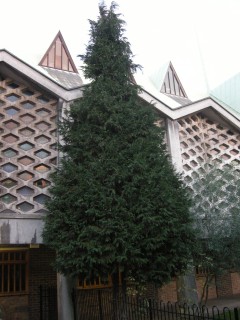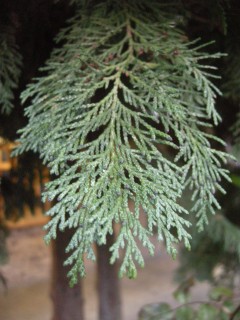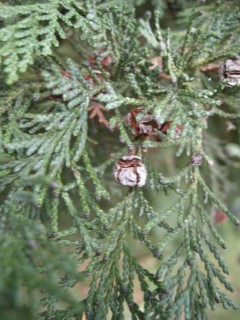Position: Full Sun
Flowering period: N/A
Soil: Moist, well drained
Eventual Height: 30m
Eventual Spread: 5m
Hardiness: 6a, 6b, 7a, 7b, 8a, 8b, 9a, 9b, 10b
Family: Cupressaceae
x Cupressocyparis leylandii is a fast growing (up to 1m each year), very dense, columnar, evergreen tree. It’s dark green leaves are flattened, with 3mm scales, bearing sharp, straight tips. The Branches of the tree appear near the base of the trunk. The Bark is dull to red/ grey in colour, bearing vertical/criss crossing shallow stringy ridges, it is often hard to see as it’s hidden beneath the foliage. This tree is monoecious. The cones, when produced, are up to 15mm across and are sterile
x Cupressocyparis leylandii, commonly known as Leylandii or Leyland Cypress, is the result of the hybridisation of two genus of trees. It has been hybridised several times to make trees of huge vigor. The tree is a cross between Cupressus macrocarpa and Chamaecyparis nootkatensis. This occurred for the first time in Leighton Hall in 1888. As x Cupressocyparis leylandii is a hybrid it is sterile. All plants in circulation in the world today are the result of a cuttings and are clones of one of the 20 original variants. This plant is synonymous with Callitropsis × leylandii. Part of the Anti – Social Behavior Act 2003 is also known as the ‘Leylandii Law’, gives a way for people affected by high hedges of any kind to have them reduced in height. Failure to comply with a notice to reduce the height of a hedge may result in a fine of up to £1,000.
The etymological root of the binomial name Cupressocyparis is derived from Cupressus, the ancient Latin for the Cypress tree and Chamaecyparis the name of the other parent of this tree. Leylandii is derived from the surname of Christopher Leyland who was the original owner of the estate in which this hybrid was developed.
The landscape architect may find x Cupressocyparis leylandii useful as a dense, evergreen screening or hedging plant. It also produces a large upright specimen tree. This tree is salt and pollution tolerant
Ecologically x Cupressocyparis leylandii is of little value to wildlife.
The Royal Horticultural Society has given x Cupressocyparis leylandii their prestigious Award of Garden Merit in 2002.
x Cupressocyparis leylandii prefers moist, well-drained soils. This tree tolerates most pH of soil.
x Cupressocyparis leylandii requires little maintenance. If being maintained as a hedge it should be cut in May.









Leave a comment